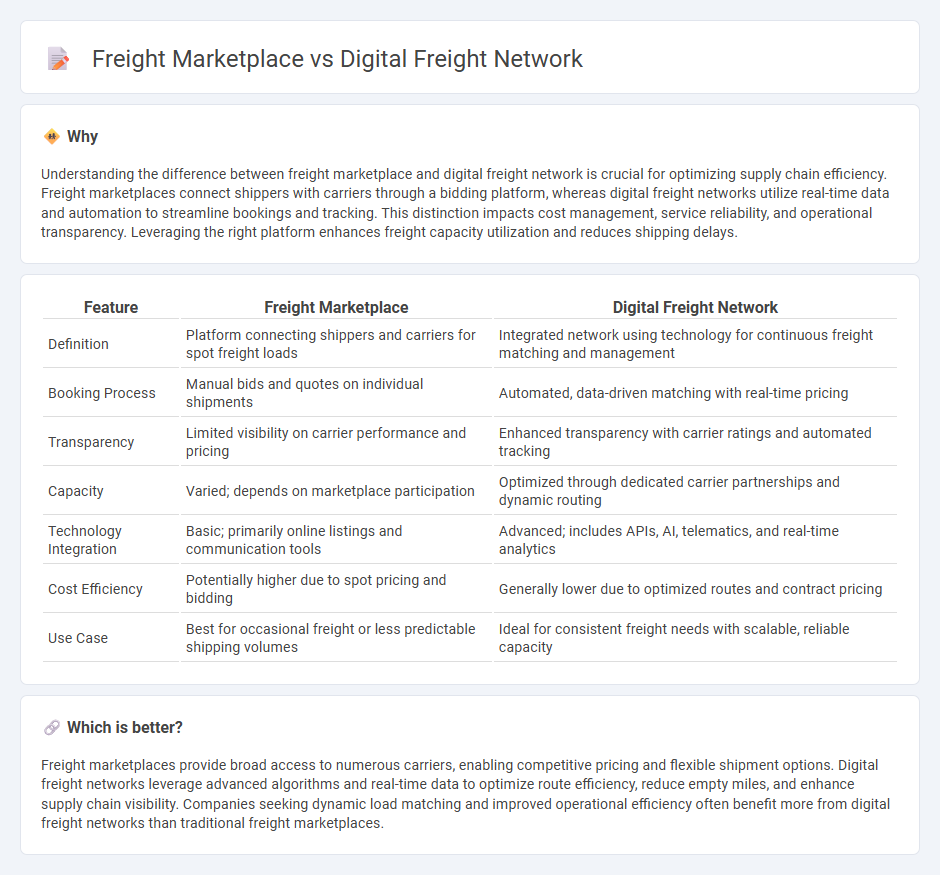
Freight marketplaces connect shippers and carriers through an open platform where transactions occur on a spot basis, offering flexibility and broad carrier access. Digital freight networks utilize advanced algorithms and real-time data to create a more efficient, automated matching process that emphasizes reliability and predictive capacity. Explore how these innovations are transforming supply chain management for greater speed and cost savings.
Why it is important
Understanding the difference between freight marketplace and digital freight network is crucial for optimizing supply chain efficiency. Freight marketplaces connect shippers with carriers through a bidding platform, whereas digital freight networks utilize real-time data and automation to streamline bookings and tracking. This distinction impacts cost management, service reliability, and operational transparency. Leveraging the right platform enhances freight capacity utilization and reduces shipping delays.
Comparison Table
| Feature | Freight Marketplace | Digital Freight Network |
|---|---|---|
| Definition | Platform connecting shippers and carriers for spot freight loads | Integrated network using technology for continuous freight matching and management |
| Booking Process | Manual bids and quotes on individual shipments | Automated, data-driven matching with real-time pricing |
| Transparency | Limited visibility on carrier performance and pricing | Enhanced transparency with carrier ratings and automated tracking |
| Capacity | Varied; depends on marketplace participation | Optimized through dedicated carrier partnerships and dynamic routing |
| Technology Integration | Basic; primarily online listings and communication tools | Advanced; includes APIs, AI, telematics, and real-time analytics |
| Cost Efficiency | Potentially higher due to spot pricing and bidding | Generally lower due to optimized routes and contract pricing |
| Use Case | Best for occasional freight or less predictable shipping volumes | Ideal for consistent freight needs with scalable, reliable capacity |
Which is better?
Freight marketplaces provide broad access to numerous carriers, enabling competitive pricing and flexible shipment options. Digital freight networks leverage advanced algorithms and real-time data to optimize route efficiency, reduce empty miles, and enhance supply chain visibility. Companies seeking dynamic load matching and improved operational efficiency often benefit more from digital freight networks than traditional freight marketplaces.
Connection
Freight marketplaces serve as digital platforms that connect shippers with carriers, enabling efficient matching based on real-time data and capacity. Digital freight networks enhance this process by integrating advanced algorithms, IoT tracking, and AI analytics to optimize routing, pricing, and load management. Together, they drive enhanced visibility, reduced costs, and faster freight matching within the logistics industry.
Key Terms
Connectivity
Digital freight networks create seamless connectivity by integrating real-time data from shippers, carriers, and logistics providers onto a unified platform, enhancing transparency and efficiency across the supply chain. Freight marketplaces primarily function as transaction hubs connecting freight buyers and sellers but often lack deeper integration or continuous data sharing. Explore how advanced connectivity in digital freight networks revolutionizes logistics operations and improves freight management.
Real-time Matching
Digital freight networks leverage real-time matching algorithms to connect shippers and carriers instantly, optimizing load assignments based on current availability, location, and capacity. Freight marketplaces generally offer listings where users manually select loads, lacking the instantaneous, data-driven matching capabilities of digital networks. Discover how real-time matching in digital freight networks revolutionizes shipping efficiency and reduces transit times.
Platform Integration
Digital freight networks leverage platform integration by connecting shippers, carriers, and third-party services within a unified digital ecosystem that enables real-time data exchange, automated booking, and dynamic pricing. Freight marketplaces primarily serve as digital matching platforms where shippers post loads and carriers find freight, but often lack the deep integration with operational systems such as transportation management systems (TMS) or carrier telematics. Explore how advanced platform integration in digital freight networks can optimize supply chain efficiency and reduce operational costs.
Source and External Links
Digital Freight Networks VS Traditional Freight Networks ... - YouTube - Digital freight networks democratize freight access by providing automated load matching and improved efficiency, reducing empty miles and lowering costs for both carriers and shippers as more participants join the network.
Leveraging Digital Freight Networks to Reduce Emissions - Digital freight networks use data pooling and proximity-based load matching to optimize truck capacity, decreasing empty backhauls and associated emissions by efficiently connecting shippers and carriers.
Transforming with technology: Linfox Digital Freight Network - Linfox's Digital Freight Network is an integrated, end-to-end platform enhancing freight visibility, safety, compliance, and efficiency through digitization and automation within a connected supply chain ecosystem.
 dowidth.com
dowidth.com